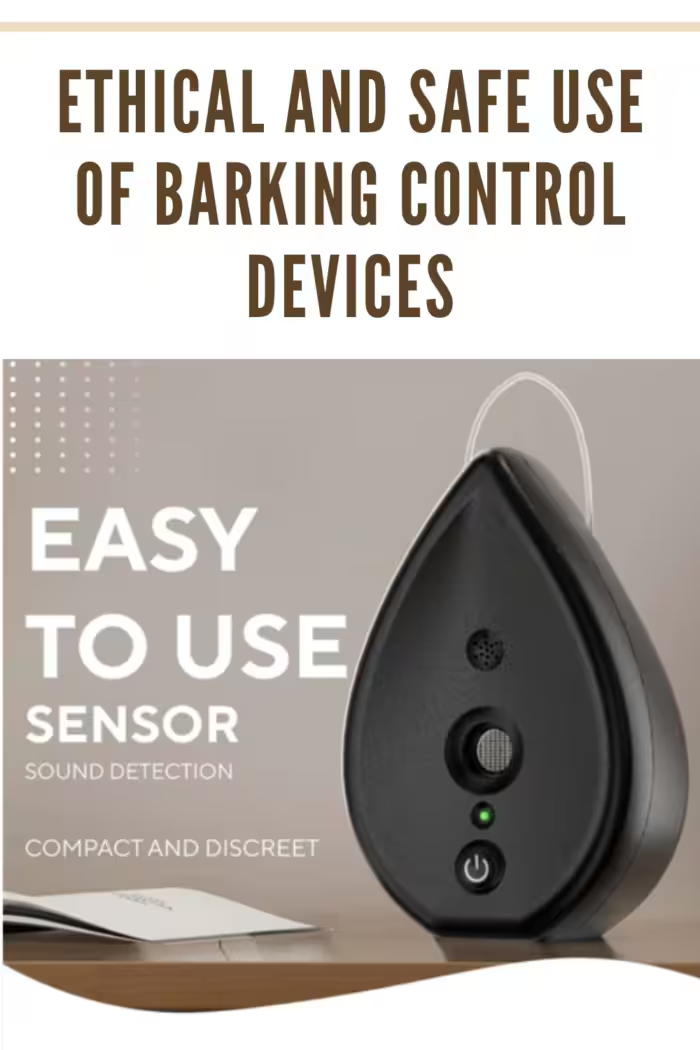Exploring Different Technologies: How Does a Stop Barking Device for Dogs Work?
Brief Explanation
Navigating through the quiet suburban neighborhoods or bustling city streets, the echoed barks of dogs often punctuate our daily lives. Unraveling the mysteries of modern technology, this exploration plunges into the world of stop barking devices for dogs, attempting to dissect the layers of technology embedded within them. These devices, designed with varying mechanisms, aim to mitigate excessive barking, introducing a semblance of serenity back into our living environments.
Objective
Embarking on this journey, the objective stretches beyond a mere technological exposition, aspiring to delve into the ethical and behavioral ramifications implicated in the utilization of stop-barking devices for dogs. This article endeavors to unravel the intricacies of these devices, dissecting their modes of operation, efficacy, and place within the larger tapestry of dog training and management methods. By demystifying the embedded technologies and presenting them in a lucid, understandable manner, it paves the way for informed decisions, advocating for a nexus between technological advancement and ethical Understanding of the Issue – Excessive Barking in Dogs.
The Nature of Barking
In the very nature of dogs, barking operates as a multifaceted mode of communication, encapsulating expressions of excitement, alarm, anxiety, and more. Yet, when this natural behavior proliferates into incessant barking, it transitions from an instinctual act to a potential issue that can strain owner-pet relationships and neighborly ties alike. Thus, understanding the roots of barking and its escalation into problematic behavior becomes pivotal in sculpting effective and humane management strategies.

The Need for Barking Control
Peering into the tapestry of daily life, instances that underline the criticality of barking management are not scarce. From nocturnal barking disrupting the tranquil veil of night to reactive barking posing challenges in social environments, the repercussions permeate living spaces’ tranquility and social harmony. For example, a survey conducted by the Noise Pollution Clearinghouse identified barking dogs as one of the most common sources of noise complaints in residential areas. Thus, the quest for barking control intertwines with broader narratives of peaceful coexistence, necessitating a dive into strategies, technologies, and methodologies designed to address it.
Overview of Stop Barking Devices
Definition and Purpose
Stop barking devices for dogs embody a technology-centric approach towards moderating and managing the barking behaviors of our canine counterparts. These devices, while varied in their mechanisms, converge on a common purpose: to curtail excessive barking in a manner that is safe and efficacious for the dog while also providing relief to pet owners and those within the acoustic radius of the barking. The intended purpose stretches beyond merely silencing dogs, venturing into realms of behavioral management, wherein the devices seek to dissuade persistent barking through various stimuli, instilling a quietude that is conducive to peaceful cohabitation and maintaining social harmony among residents.
Popular Types of Stop Barking Devices
Navigating through the marketplace, you encounter a diverse array of stop-barking devices, each boasting its unique technological methodology to tackle barking dilemmas. Ultrasonic devices, for instance, emit a high-pitched sound, invisible to most humans but discernible to dogs, acting as a deterrent to interrupt and dissuade barking. Vibration collars, on the other hand, detect barking through vibration sensors and respond by delivering a harmless vibratory stimulus to the dog, which is intended to divert them from their barking spree. Furthermore, static correction collars introduce a mild static stimulus as a barking deterrent, while spray collars emit a harmless spray that startles the dog into silence. Each device, while diverse in mechanism, seeks to weave into the fabric of barking management, offering varied approaches toward a common goal: mitigating excessive barking.

The Science Behind the Technologies
- Ultrasonic Devices
Ultrasonic devices, veiled in scientific ingenuity, employ sounds at frequencies beyond the perceptual reach of the human ear—typically above 20,000 Hz. With their heightened auditory capacities, dogs perceive these ultrasonic sounds, which act as a deterrent, disrupting their barking by introducing a novel stimulus that captures their attention. The underlying science hypothesizes that the emitted sound, given its
- Static and Vibration Collars
Embarking further into the technological realm, static and vibration collars emerge as devices that amalgamate sensory technology with behavioral correction methodologies. These collars, typically equipped with sensors capable of detecting the vibrations engendered by barking, respond by emitting a mild static correction or a vibratory stimulus. This resultant stimulus serves a dual purpose: it not only diverts the dog’s attention from the barking but also associates the undesirable behavior with an unexpected, albeit harmless, consequence, working towards gradual behavior modification.
-
Other Technologies
Beyond the realms of ultrasonic, static, and vibratory technologies lie an array of other innovations, each sculpting its niche within the barking control domain. For instance, spray collars utilize a burst of citronella spray as a barking deterrent, leveraging the dog’s dislike for the citrus scent to discourage the behavior. Furthermore, advancements in smart technology introduce devices that sync with mobile applications, providing owners with insights into their dogs’ barking patterns and enabling more nuanced management approaches. These assorted technologies, each with their unique scientific underpinnings and applications, enrich the palette of Efficacy and Limitations.
- Success Stories
Digging into the corpus of various instances and studies, some narratives uphold the efficacy of stop barking devices in mitigating unwarranted canine vocalizations. In certain cases, owners have testified to the perceptible reduction in their dogs’ barking following the implementation of devices like ultrasonic bark controllers and vibration collars. The quintessence of these success stories often pivots around the immediate interruption of the barking behavior stemming from the unexpected stimuli introduced by the device. Some scientific studies, albeit limited, have also ventured into this terrain, exploring the tangible impacts of these devices on barking reduction, often surfacing with varied results that oscillate between efficacy and inconclusiveness.
- Limitations and Concerns
Pivoting towards a critical lens, the discussion of stop barking devices is not devoid of limitations and ethical quandaries. On a functional level, limitations pertain to the generalization of effectiveness across all dogs, acknowledging the diversity in temperaments, sensitivities, and responsiveness to the devices. Additionally, concerns often percolate around the ethical implications of utilizing aversive stimuli in behavior modification. The potential for inducing stress, anxiety, or fear in dogs, alongside the risk of fortifying negative associations with certain contexts or stimuli, unfurls a tapestry of ethical and behavioral considerations that necessitate contemplation and exploration.
Ethical and Safe Use of Barking Control Devices
-
Ensuring Animal Welfare
The paramountcy of animal welfare remains non-negotiable amidst the technological discourse. Navigating through the varied devices, ensuring that the selected methodologies do not inflict physical or psychological distress upon the dog, emerges as a pivotal concern. Advocacy for devices that prioritize humane interactions, such as those that do not introduce sharp or painful stimuli, aligns closely with overarching narratives of ethical animal management and welfare.
-
Legal Aspects
Treading into the legal corridors, guidelines, and constraints concerning the usage of stop-barking devices often exhibit geographical variations. While certain regions may embrace leniency, others impose stringent regulations to safeguard animal welfare. Hence, acquainting oneself with local, regional, and national legislation regarding such devices’ ethical and legal use becomes an imperative task for responsible pet ownership and management.
-
Professional Input
Involving professionals, such as veterinarians and animal behaviorists, in the decision-making process regarding barking management introduces a layer of expertise and ethical consideration into the narrative. Professionals can provide insights into the root causes of excessive barking, propose tailored management strategies, and guide towards the ethical, safe, and effective utilization of stop barking devices if deemed suitable.

Alternatives to Stop Barking Devices
-
Positive Reinforcement Training
Exploring realms beyond technological interventions, positive reinforcement training surfaces as a potent alternative. Rooted in the reinforcement of desired behaviors through positive stimuli, such as treats or praise, this methodology fosters a positive learning environment, wherein the dog learns through associations with rewarding consequences, potentially sculpting behavior without introducing aversive stimuli.
-
Consulting Professionals
Engaging with professional trainers and behaviorists ushers in an era of tailored, dog-specific approaches toward barking management. Professionals can dissect the behavioral patterns, triggers, and underlying causes of excessive barking, forging strategies rooted in scientific, ethical, and effective paradigms of animal behavior management.

Conclusion
Summarizing Key Points
Recapitulating the journey, from exploring the technological marvels of stop barking devices to navigating through the corridors of ethical, legal, and behavioral considerations, the tapestry of canine barking management unfolds in its multifaceted glory.
Final Thoughts
The synthesis of technology and ethical animal management, while intricate, illuminates pathways that can potentially harmonize our coexistence with our canine companions, always tethered to the principles of welfare, empathy, and understanding.
Encouragement for Responsible Use
In the final strokes, the encouragement for responsible and humane use permeates the narrative, urging users to tread the path where technology meets ethicality, ensuring that the voices of our canine companions are heard, understood, and managed with compassion and knowledge.
